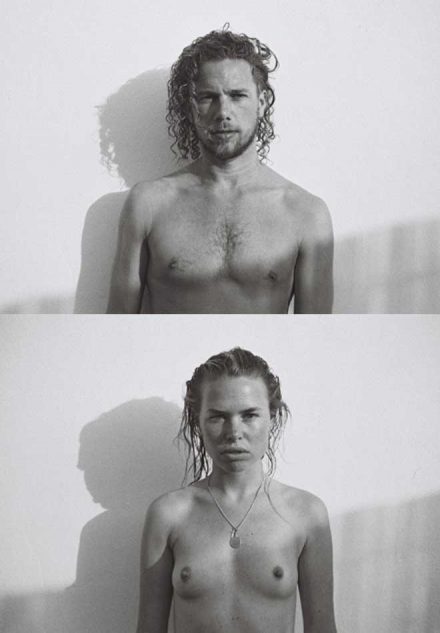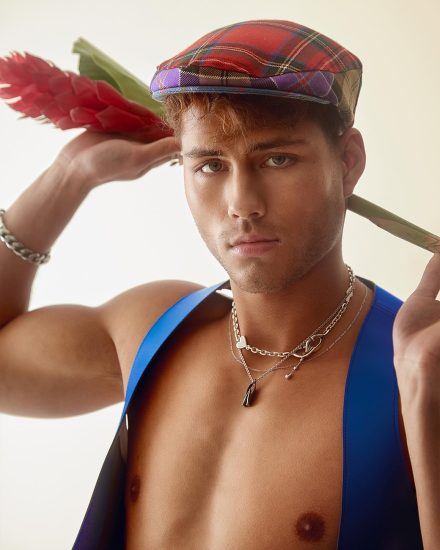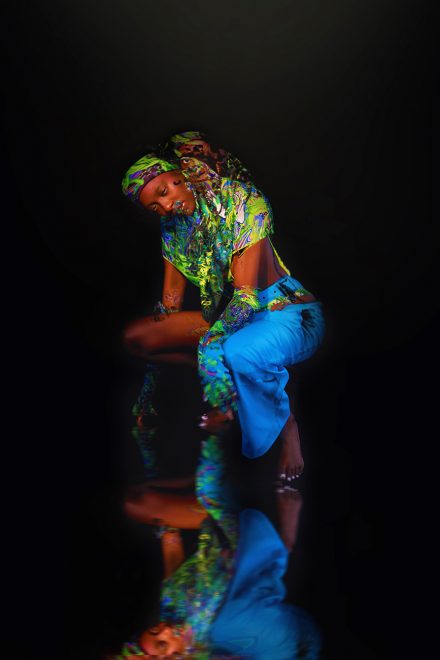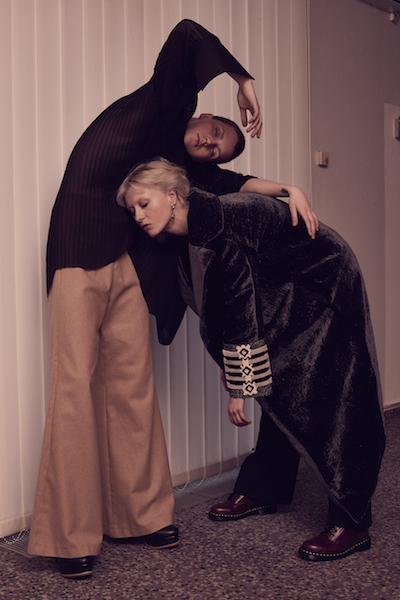
“[Y]outh is a transient stage. […] I wanted to invite everyone to stay in this world”.
Gosha Rubchinskiy, 032c Issue #29, 2015
The world of Gosha Rubchinskiy is marked in it’s acting as a space in which the wealth of youth culture is enabled to come into full bloom. Indeed, this innovatively nuanced approach has brought about the coining of a moniker supposedly applicable to his oeuvre, “Post-Soviet Youth”. Yet it is only in the narrow context of blind infatuation with an ignorantly perceived ‘dystopian glamour’ that such a term can be though of as anything but reductive, for to concretise the Rubchinskiy creative project in such rigid linguistic terms is to eschew the complexity and dynamism at its core.
At St Agnes, a pinnacle of Berlin Brutalism, an exhibition of Rubchinskiy’s photography graced 032c’s eponymous gallery. Images of alabaster-hued Bowie-esque figures in Bottega Veneta sweatshirts meet denim-clad skinheads, cast against the backdrop of a concert, a scene of the unbridled turbulence and care-free celebratory revolution typical of younger days. Underpinning this series of seemingly incongruous images is a precarious balance, a harmony of contrasts; what initially appears as a quasi-comic assembling of heteroclite features becomes a fondly nostalgic testament, one inextricably synonymous with youth, and therefore with an essential context of human experience. While the subjects documented may appear alien, objects worthy of fascination and fetish, the source from which they stem is irrefutably one from which each and every one of us draws creative and personal sustenance.
Yet to entirely remove the images, be they taken as independent entities or as respective components of Rubchinskiy’s wider corpus, from their cultural and historical contexts is an error in itself. “[I]t’s not about a specific time. It’s more about a special state: childhood in that reality[,][…] Russia and Eastern Europe in the late 80s, early 90s”. And the infusion of lived experience is undeniably an aspect that manifests itself most distinctly across the exhibition, with each image warmly evoking a particular moment, space or period in time. This does not go to say that an intimate acquaintance with the cultural, socio-political and philosophical climates of early 90s Russia is requisite for an understanding of Rubchinskiy’s project. It is, after all, the apt consolidation of personal, cultural and common experiential memory that allows for a stark relatability, that which has catapulted him into the spotlight across a breadth of creative fields.
It should not be discounted that it is his being a part, or perhaps more accurately a protagonist, of a so-called “Post-Soviet Youth” that allows for the succinct observations, critiques and parodies that pepper his work. Indeed, having experienced the breakneck shift from a ‘deprivation’ to an abundance of ‘the West’, he brings with him a fresh perspective and interpretation of cultural cornerstones long deemed irreproachable. In two particularly striking images, Rubchinskiy’s trademark decoding and recontextualisation feature in a manner most conspicuous. In the first, a skinhead glares defiantly down the lens, swathed in blue denim, sourced from none other that Dior Homme, from under which a graphic tee, the stylists own, peeks through. In the shuttering of a lens, the dogmas of luxury crumble; the house of Dior is demoted to a prop in a bolshy performance of youth. Next, a cherubic figure stands demurely in high-waisted jeans, into which a t-shirt is meticulously tucked. On the t-shirt itself, a portrait of a winking Putin is proudly emblazoned; the symbolic power of institutional politics disintegrates, crippled by youth’s fearlessness to test boundaries, to seize ownership of meanings and to re-stitch the very fabric out of which endless generations have diligently crafted them.
The hacking, or rather hijacking, of symbol and meaning is yet another facet that Rubchinskiy’s idiosyncratic creative approach staunchly facilitates. In his A/W 2015/16 collection, entitled ‘Sport’, he “hacked [a] Tommy Hilfiger t-shirt with Russian and Chinese flags [, encapsulating] how a nostalgia for Russian adolescence has been fractured across time and space to address new international concerns”(Anastasiia Fedorova, 032c Issue #29, 2015). Of course, the iconoclasm of an oft fetishised stalwart of all-American prep highlights the commonality of both youth experience and fantasy. Yet particular intrigue in Rubchinskiy’s methodology lies in the radical leveling of symbols and icons, simultaneously undermining and updating the fusty visual tropes of era’s long-since past. 
Returning to the exhibition, it’s curation can be argued to explicitly allude to this notion of iconic equality. Below the photos lie two flags; one bears an icon of Christ, the other, the flag of the Russian Federation, crest intact. These two pillars of Russian culture and society, state and church, appear out of place, their gravity and power overridden by the unrefined energy of youth of the images above. Yet, they act as the only frame in which such novel expression can come to fruition, a frame so rigidly and repeatedly reinforced that the force exerted against it’s boundaries from within has no option but to be exponentially amplified.
In perhaps the most poignant implementation of iconography, a scarf drapes vertically to the right-hand side of the exhibition, a piece of memorabilia dedicated to one of Russia’s most widely-celebrated bands, Кино́ (Kino). Penning simple and relatable lyrics, more often testaments to the virtues of freedom than to any overtly political motifs or campaigns, they arguably embody the same ethics and quintessentially of youth as does Rubchinskiy. The implementation, parodying and creation of iconography is therefore less to do with making a testament, or paying homage, to any individual component or distinct phenomenon, but rather to the accumulation of objects, phenomena and experiences that constitute youth itself. Be it through the medium of photography or fashion, youth is the sacred object of worship, fetish and idolisation; the attempt is not to capture, concretise or rationalise, but to observe its ephemerality. This perhaps explains the transcendence, ambiguity and enigma that surround both the exhibition and Rubchinskiy’s wider oeuvre. After all, youth speaks no language, yet youth is ambitious, arrogant, uncompromising. Youth transports the strict codes of the everyday into spaces of unbridled liberty, beyond the reach of the suffocative mechanisms necessitated by institution. These are the precise spaces that Rubchinskiy’s work both creates and occupies.
“He doesn’t remember the word ‘yes’ or ‘no,
He doesn’t remember any ranks or names
And he can reach for the stars
Aside from it’s a dream,
And he falls, burned by the star
By the name of Sun”
“The Star Called Sun”, Kino, 1988

All images taken from the Gosha Rubchinskiy Exhibition at 032c Workshop/Joerg Koch




